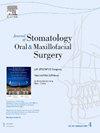Antley-Bixler syndrome: a case report on virtual planning for monobloc distraction osteogenesis and a surgical intervention narrative review
IF 2
3区 医学
Q2 DENTISTRY, ORAL SURGERY & MEDICINE
Journal of Stomatology Oral and Maxillofacial Surgery
Pub Date : 2025-04-18
DOI:10.1016/j.jormas.2025.102382
引用次数: 0
Abstract
Background
Antley-Bixler syndrome (ABS) is an extremely rare genetic disorder characterized by distinct features such as trapezoidal face craniosynostosis, midface hypoplasia with exorbitism, depressed nasal bridge, chonal atresia, radio-humeral synostosis, joint contractures and arachnodactyly.
Objective
The aim of our study is to: (i) Comprehensively analyse available literature on ABS and report on the surgical management as well as treatment outcomes. (ii) Describe a case of ABS that has been successfully treated with monobloc distraction osteogenesis via virtual surgical planning.
Methods
A PUBMED search was performed in June 2024. The search was based on a general search string limited to “Antley-Bixler”. Inclusion criteria included systematic reviews preferably with meta-analysis, randomized controlled trials, cohort studies and case reports that were reported in English.
Results
Papers that focussed on surgical techniques were only present in the form of case reports and case series, out of which only 8 papers that fulfilled the inclusion criteria were included. Surgical techniques that were reported on included fronto-orbital advancement, midfacial advancement, distraction osteogenesis and others. The reported patients also underwent several other surgical procedures for either functional or aesthetic purposes. All the patients reported a good outcome from their surgical interventions.
Conclusion
Monobloc distraction osteogenesis is one of the most reliable and predictable procedures that may solve various problems associated with complex craniofacial deformities such as in ABS. This can be seen from the favourable outcome reported in several studies. However, comprehensive pre-surgical virtual planning and multidisciplinary care contributes greatly to favourable functional outcomes.
Antley-Bixler综合征:虚拟计划治疗单块牵张成骨和手术干预的一例报告。
背景:Antley-Bixler综合征(ABS)是一种极其罕见的遗传性疾病,其特征明显,如面部颅缝闭锁、面中部发育不全伴外凸、鼻桥凹陷、软骨闭锁、桡侧肱关节闭锁、关节挛缩和蛛网膜畸形。目的:我们的研究目的是:(1)综合分析ABS的现有文献,报道手术治疗和治疗效果。(ii)描述一个通过虚拟手术计划成功治疗单块牵张成骨的ABS病例。方法:于2024年6月在PUBMED检索。搜索是基于一般的搜索字符串,仅限于“Antley-Bixler”。纳入标准包括系统评价,最好有荟萃分析、随机对照试验、队列研究和用英语报道的病例报告。结果:以手术技术为主的文献仅以病例报告和病例系列的形式出现,其中符合纳入标准的文献仅8篇。报道的手术技术包括额眶推进、面中推进、牵张成骨等。报道的患者也接受了其他一些手术,无论是功能或美观的目的。所有患者均报告手术干预的良好结果。结论:单块牵张成骨是最可靠和可预测的手术之一,可以解决复杂颅面畸形(如ABS)相关的各种问题。这可以从几项研究报道的良好结果中看出。然而,全面的术前虚拟计划和多学科护理有助于良好的功能预后。
本文章由计算机程序翻译,如有差异,请以英文原文为准。
求助全文
约1分钟内获得全文
求助全文
来源期刊

Journal of Stomatology Oral and Maxillofacial Surgery
Surgery, Dentistry, Oral Surgery and Medicine, Otorhinolaryngology and Facial Plastic Surgery
CiteScore
2.30
自引率
9.10%
发文量
0
审稿时长
23 days
 求助内容:
求助内容: 应助结果提醒方式:
应助结果提醒方式:


